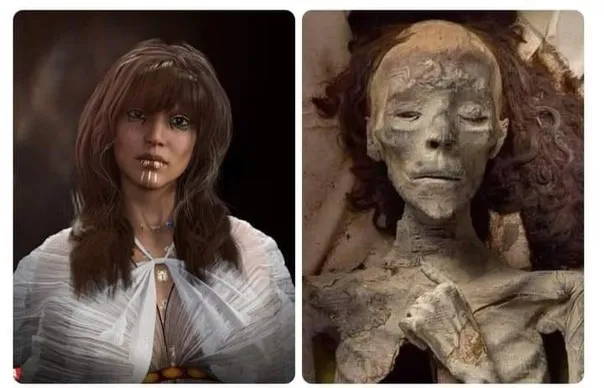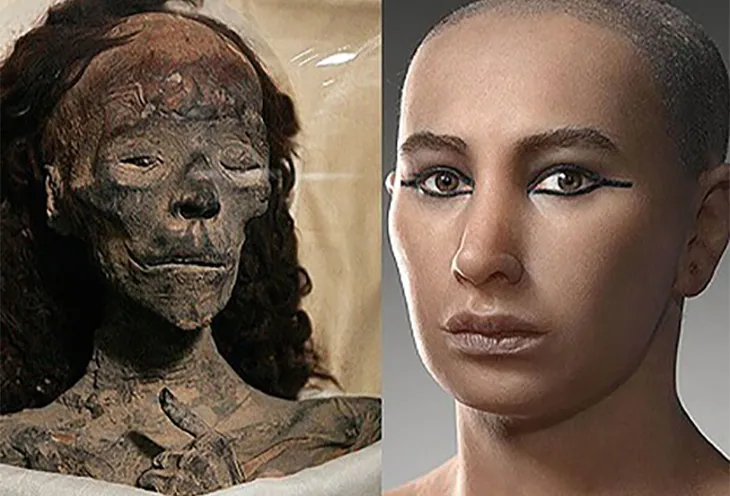In the grand narrative of ancient Egypt, a civilization known for its monumental temples, intricate belief systems, and powerful dynasties, few women left as indelible a mark as Queen Tiye. Living in the 14th century BC, she was the Great Royal Wife of Pharaoh Amenhotep III, the mother of Pharaoh Akhenaten, and the grandmother of the boy-king Tutankhamun. Tiye’s influence was profound, extending beyond family ties into the political, religious, and diplomatic life of Egypt’s 18th Dynasty. For centuries, her name and achievements were known through inscriptions, statues, and historical records. Yet the details of her physical appearance remained elusive—until modern science stepped in. Recently, researchers combined forensic technology and artistic interpretation to reconstruct Queen Tiye’s face from her preserved remains. The result offers not just a likeness of a queen, but a striking bridge between antiquity and the present.
The Importance of Queen Tiye

To understand why this reconstruction matters, one must first appreciate Queen Tiye’s historical significance. She was not born into the royal family but rose to power through marriage, an unusual trajectory in a society where lineage carried immense weight. Contemporary records describe her as strong-willed, politically savvy, and deeply respected both within and beyond Egypt’s borders. Tiye played a role in international diplomacy, corresponding with rulers of neighboring states. She also influenced the religious changes initiated by her son, Akhenaten, who introduced the worship of Aten, the sun disk, in what many regard as one of history’s earliest experiments in monotheism. Through her grandson Tutankhamun, Tiye’s legacy extended into the most iconic discovery in Egyptology: the treasures of the boy king’s tomb, unearthed in the Valley of the Kings in 1922. Understanding her appearance, therefore, adds a human dimension to a woman already central to one of the most transformative periods in Egyptian history.
The Mummy in Cairo
The mummy identified as Queen Tiye rests today in the National Museum of Egyptian Civilization in Cairo. Unlike Tutankhamun’s golden burial, Tiye’s remains endured centuries of relocation and damage, yet enough survived to provide invaluable data. Forensic scientists studying her mummy noted that despite the wear of time, the skeletal structure was intact enough to attempt a reconstruction. This sparked a project that brought together archaeologists, medical experts, and artists, combining their expertise to reveal her visage.
The Reconstruction Process
The process of facial reconstruction is meticulous, blending hard science with informed artistry.
CT Scanning: Researchers first subjected the mummy to high-resolution CT scans, producing detailed three-dimensional images of the skull. These scans revealed bone structure, jaw alignment, and cranial features, creating a digital framework for the reconstruction.
Forensic Anthropology: Specialists analyzed the skull to estimate facial muscle thickness, tissue depth, and likely soft tissue contours. By comparing with both modern anatomical data and remains from the same period, they could approximate features such as nose shape, cheekbones, and jawline.
Artistic Interpretation: Once the scientific foundation was laid, artists created a lifelike model. This step involved not only translating data into visible features but also considering cultural context—hairstyles, adornments, and stylistic norms of the 18th Dynasty.
Historical Integration: Researchers cross-referenced their reconstruction with statues and reliefs depicting Tiye. While ancient art was idealized, these references provided clues about how she was portrayed in her time.
The result was a composite image: a woman with strong features, regal presence, and a face that echoed both authority and resilience.
Why Reconstruct Ancient Faces?

Facial reconstructions are not simply curiosities. They humanize history. For generations, Queen Tiye was a name in inscriptions or a figure carved in stone. Now, she is a face—a reminder that behind the politics and monuments stood real people. Such reconstructions also help correct misconceptions. Ancient Egyptian art often stylized faces according to cultural conventions; forensic reconstructions add nuance, reminding us that historical figures were flesh and blood, not just symbols. Moreover, reconstructions inspire public engagement. Visitors who see Queen Tiye’s likeness in museums connect emotionally in a way that textual descriptions alone cannot achieve. It is the difference between reading about history and encountering it.
The Reaction and Scholarly Impact
The unveiling of Queen Tiye’s reconstructed face captured wide attention. Scholars welcomed it as a valuable addition to Egyptology, while the public was fascinated by the ability to see a queen who lived over 3,000 years ago. Beyond the visual impact, the reconstruction emphasizes the potential of interdisciplinary research—how forensic science, archaeology, and art can work together to illuminate the past. For Egypt, it also reinforces national pride, showcasing technological innovation alongside cultural heritage. The project has become a symbol of how modern Egypt continues to unlock the secrets of its ancient civilization.
Queen Tiye’s Legacy in Context
Queen Tiye’s story resonates today because it highlights the power of women in ancient societies often thought of as male-dominated. She was not merely a consort; she was a partner in governance, a participant in diplomacy, and an influence on religious reform. Her reconstruction serves as a reminder that history’s most transformative figures are not always kings or warriors, but also queens, mothers, and advisors who shaped decisions behind the throne. By studying her life and now her reconstructed image, historians gain insight into how women wielded power in ways that were subtle yet enduring.
A Window Into the Ancient World
Reconstructing faces from mummies is part of a broader trend in archaeology, where advanced science makes the past tangible. CT scanning has revealed hidden amulets within wrappings, 3D modeling has recreated ancient temples, and DNA analysis has traced lineages across centuries. In Queen Tiye’s case, the reconstruction does more than give us a face—it provides an intimate connection to a woman whose influence still echoes in the stories of Akhenaten’s religious revolution and Tutankhamun’s golden legacy. Each technological advance deepens our ability to see antiquity not as distant or abstract, but as part of a continuum that still shapes our present.
Conclusion: Meeting Queen Tiye Again
Standing before Queen Tiye’s reconstructed face is like meeting history in person. The features are both familiar and foreign, a blend of scientific precision and cultural artistry. They remind us that ancient Egypt was not just pyramids and pharaohs, but people with ambitions, struggles, and legacies that continue to inspire. For modern audiences, the reconstruction is not chilling or terrifying—it is profound. It is a chance to encounter one of Egypt’s greatest queens, to see the humanity in her eyes, and to reflect on how her world shaped ours. As science continues to unlock new dimensions of the past, faces like Queen Tiye’s ensure that history remains alive, personal, and endlessly fascinating.
Sources:
